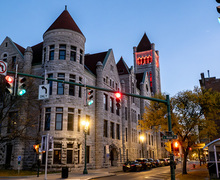Tree-vival : Scientists attempt to re-establish functionally extinct tree after 25 years of research
Illustration by Andy Casadonte | Art Director
After about 25 years of research, SUNY-ESF scientists will attempt to re-establish the American chestnut tree, which was previously functionally extinct.
“Twenty-five years, $5 million and two full careers later, we’re still working on it,” said Chuck Maynard, the tissue culture specialist on the project. He became involved in the mid-1980s, when the president of the American Chestnut Foundation, Phil Rutter, came to Syracuse to spread the word about the destruction of the American chestnut tree.
Collin Bartholomew, research analyst at the State University of New York College of Environmental Science and Forestry, said the project has taken a lot of time because of all the careful research involved. “We need to look at all of the ecological impacts between the chestnut trees and the surrounding vegetation. Any mistake could devastate the entire forest.”
In the past 30 years, the Cryphonectria parasitica fungus has killed American chestnut trees, especially on the East Coast, said Linda McGuigan, the lab manager on the project. McGuigan said the Appalachian Mountains were approximately 25 percent American chestnut before the fungus was introduced to the ecosystem.
Scientists at ESF have collaborated to form a blight-resistant American chestnut tree by breeding it with a Chinese chestnut tree, McGuigan said. The offspring of the two trees have been bred with other American chestnuts to create an offspring that is 15 of 16 American chestnut, she said.
“We’re trying to re-establish a dominant tree species back into the forest,” Bartholomew said, referencing the fact that American chestnuts used to dominate East Coast forests. He said American chestnuts taste better than Chinese chestnuts and are of higher quality.
ESF has provided continuous support to these scientists, funding the lab and even matching the money the team spends on growth chambers and microscopes, said Maynard, the tissue culture specialist. The team also uses ESF’s Lafayette Road Experiment Station for tests on the trees in the field, he said.
The team is not able to distribute the chestnut trees yet because of a Food and Drug Administration regulation, Bartholomew said. They are currently keeping the trees in a fenced-in area so that deer can’t get in and move the genes around by carrying chestnuts to other areas of the forest, he said.
The scientists are currently narrowing it down to two or three species that will be re-introduced into the Lafayette Road Experiment Station next summer.
ESF professors, such as Donald Leopold of the environmental and forest biology department, also support the team’s work.
Said Leopold in an email: “I think the research being done by Drs. Bill Powell and Chuck Maynard, including their team, on American chestnut, is the single most important research project done in the 100-plus-year history of ESF.”
Published on October 21, 2013 at 12:20 am





